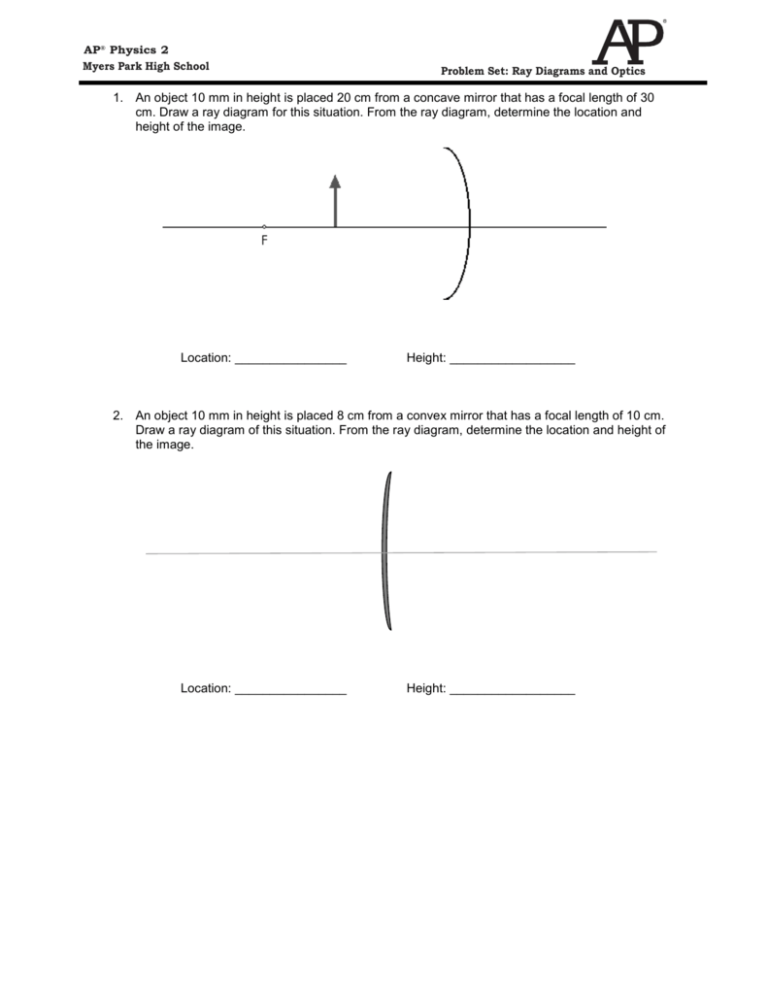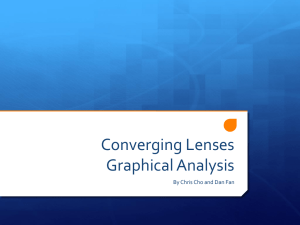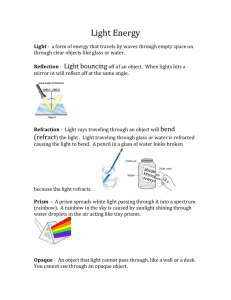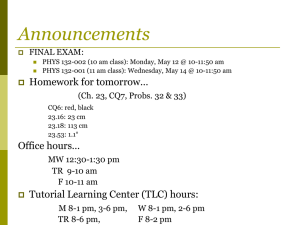PROBLEM SET Ray Diagrams and Optics
advertisement

AP® Physics 2 Myers Park High School Problem Set: Ray Diagrams and Optics 1. An object 10 mm in height is placed 20 cm from a concave mirror that has a focal length of 30 cm. Draw a ray diagram for this situation. From the ray diagram, determine the location and height of the image. Location: ________________ Height: __________________ 2. An object 10 mm in height is placed 8 cm from a convex mirror that has a focal length of 10 cm. Draw a ray diagram of this situation. From the ray diagram, determine the location and height of the image. Location: ________________ Height: __________________ AP® Physics 2 Myers Park High School Problem Set: Ray Diagrams and Optics 3. An object 10 mm in height is placed 20 cm from a converging lens that has a focal length of 10 cm. Make a ray diagram of this situation. From the ray diagram, determine the location and height of the image. Location: ________________ Height: __________________ 4. An object 15 mm in height is placed 30 cm from a converging lens that has a focal length of 10 cm. Make a ray diagram of this situation. From the ray diagram, determine the location and height of the image. Location: ________________ Height: __________________ 5. An object 10 mm in height is placed 30 cm from a diverging lens that has a focal length of - 10 cm. Make a ray diagram of this situation. From the ray diagram, characterize the image. Location: ________________ Height: __________________ AP® Physics 2 Myers Park High School Problem Set: Ray Diagrams and Optics MULTIPLE CHOICE QUESTIONS 1. Light travels fastest in _____. a. water b. vacuum c. air d. glass 2. Refraction, as light goes from air to glass, results from differences in light's _____. a. frequency in air and glass b. incident angle c. speed in air and glass d. all of the above. 3. Light refracts when traveling from air into glass because light _____. a. intensity is greater in air than in glass. b. frequency is greater in glass than in air. c. speed is greater in air than in glass d. polarization is greater in glass than in air 4. A beam of light emerges from water into air at an angle. The beam is bent _____. a. toward the normal b. away from the normal c. at an angle of 49° d. only if it is polarized 5. When a light beam emerges from water into air, the light speed _____. a. increases b. remains the same c. decreases 6. The image of the arrow is smaller than the arrow itself in which of the following cases? a. I only b. II only c. I and III only d. II and III only e. I, II and III 7. An object is placed near a plane mirror, as shown above. Which of the labeled points is the position of the image? a. A b. B c. C d. D e. E AP® Physics 2 Myers Park High School Problem Set: Ray Diagrams and Optics SLIGHTLY MORE CHALLENGING 1. Two converging lenses have focal lengths f 1 = 30 cm and f2 = 20 cm. They are placed 60 cm apart along the same axis and an object is placed 50 cm from lens #1 on the side opposite lens #2. Locate the final image and calculate its overall magnification. State the final image characteristics relative to the original object. Sketch the ray diagram. AP® Physics 2 Myers Park High School Problem Set: Ray Diagrams and Optics ANSWERS 3. An object is placed 20 cm from a converging lens that has a focal length of 10 cm. Make a ray diagram of this situation. From the ray diagram, characterize the image. The image is real, same size, beyond the mirror and inverted 2. An object is placed 30 cm from a converging lens that has a focal length of 10 cm. Make a ray diagram of this situation. From the ray diagram, characterize the image. The image is real, inverted, beyond the mirror and smaller. AP® Physics 2 Myers Park High School Problem Set: Ray Diagrams and Optics 3. An object is placed 5 cm from a converging lens that has a focal length of 10 cm. Make a ray diagram of this situation. From the ray diagram, characterize the image. The image is virtual, upright, in front of the lens and larger 4. An object is placed 30 cm from a diverging lens that has a focal length of - 10 cm. Make a ray diagram of this situation. From the ray diagram, characterize the image. The image is virtual, upright, in front of the lens and smaller. AP® Physics 2 Myers Park High School Problem Set: Ray Diagrams and Optics 5. An object is placed 20 cm from a concave mirror that has a focal length of + 30 cm. Make a ray diagram of this situation. From the ray diagram, characterize the image. The image is virtual, upright, inside the mirror and larger. MULTIPLE CHOICE QUESTIONS 1. Light travels fastest in a. water b. vacuum c. air d. glass 2. Refraction, as light goes from air to glass, results from differences in light's a. frequency in air and glass b. incident angle c. speed in air and glass d. all of the above. 3. Light refracts when traveling from air into glass because light a. intensity is greater in air than in glass. b. frequency is greater in glass than in air. c. speed is greater in air than in glass d. polarization is greater in glass than in air AP® Physics 2 Myers Park High School Problem Set: Ray Diagrams and Optics 4. A beam of light emerges from water into air at an angle. The beam is bent a. toward the normal b. away from the normal c. at an angle of 49° d. only if it is polarized 5. When a light beam emerges from water into air, the light speed a. increases b. remains the same c. decreases SLIGHTLY MORE CHALLENGING 1. Two converging lenses have focal lengths f1 = 30 cm and f2 = 20 cm. They are placed 60 cm apart along the same axis and an object is placed 50 cm from lens #1 on the side opposite lens #2. Locate the final image and calculate its overall magnification. State the final image characteristics relative to the original object. Sketch the ray diagram. Start with Lens #1. Given do1 = 50 cm f1 = 30 cm Required di1 Analyze 1/do1 + 1/di1 = 1/f1 Solve 1/di1 = 1/30 – 1/50 1/di1 = (50-30)/1500 1/di1 = 20/1500 di1 = 1500/20 di1 = 75 cm Now, move to Lens #2 The image formed by the first lens is the object for the second lens. Since the lenses are 60 cm apart, the "object" must be 15 cm away from lens #2 on the transmission side or beyond the lens (75-60 = 15). Thus, the "object" is thus virtual and do2 = -15 cm. AP® Physics 2 Myers Park High School Problem Set: Ray Diagrams and Optics Given f2 = 20 cm do2 = -15 cm Required di2 Analyze 1/do2 + 1/di2 = 1/f2 Solve 1/di2 = 1/f2 + 1/do2 1.di2 = 1/20 – (-1/15) 1/di2 = (15 + 20)/300 1/di2 = 35/300 di2 = 300/35 di2 = +8.57 cm The final image is positive. Therefore, the final image is located on the transmission side of the second lens. Since it is the real light, the image is real. Finally, the overall magnification -- Recall M = -(di / do) In this case, there are two lenses. Thus M = M1 M2 M = (-(di1/do1)) X (-(di2/do2)) M = (-(75/50)) X (-(8.57/-15)) M = (-1.5) X (0.57) M = -0.86 Image is measured by 100%. Since M < 100, it is smaller than the original object. The final image is inverted and 86% of the original size.









